Their favourite exhibits are as varied as the staff themselves. Our team introduces them to you:
Management
Marianne Tazlari
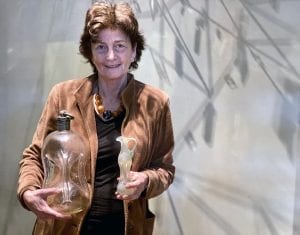 Marianne Tazlari finds it difficult to decide on a favourite piece: the Guttrolf jug from the 3rd century AD or the large Guttrolf drinking bottle from the 15th century? The ancient multi-tubular joke articles, also called "Angster" or "Guttrolfe", made drinking and serving difficult due to their unusual shape. Often something went wrong - to the amusement of the guests present. The approximately 20 Guttrolfe form the beginning, the "heart" of Löber's passion for collecting, which is primarily concerned with the lost technology of the Guttrolf goblets (How did the 3-5 tubes come about?) and glass technologies in general.
Marianne Tazlari finds it difficult to decide on a favourite piece: the Guttrolf jug from the 3rd century AD or the large Guttrolf drinking bottle from the 15th century? The ancient multi-tubular joke articles, also called "Angster" or "Guttrolfe", made drinking and serving difficult due to their unusual shape. Often something went wrong - to the amusement of the guests present. The approximately 20 Guttrolfe form the beginning, the "heart" of Löber's passion for collecting, which is primarily concerned with the lost technology of the Guttrolf goblets (How did the 3-5 tubes come about?) and glass technologies in general.
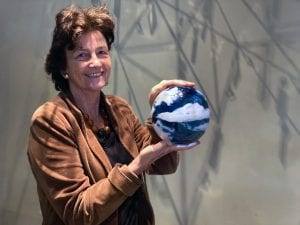 The latest exhibit from 2019 is also one of the museum director's favorites: the Sky-Graal/Himmels vase by Heide Breit (Zwiesel/Bayer.Wald) is made using the so-called Graal technique. The complex multi-layered process creates glass objects such as the "blue" planet here - enveloped in white clouds. Marianne Tazlari: "For me, this is not a decorative, masterfully crafted utilitarian object, but an artistic expression of our time and its fragility. What other material than glass could have done this better?"
The latest exhibit from 2019 is also one of the museum director's favorites: the Sky-Graal/Himmels vase by Heide Breit (Zwiesel/Bayer.Wald) is made using the so-called Graal technique. The complex multi-layered process creates glass objects such as the "blue" planet here - enveloped in white clouds. Marianne Tazlari: "For me, this is not a decorative, masterfully crafted utilitarian object, but an artistic expression of our time and its fragility. What other material than glass could have done this better?"
Barbara Benz
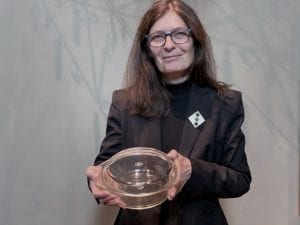 Almost everyone has Barbara Benz's favourite piece at home: the vegetable bowl made of fireproof "Jenaer Glas". "It always pleases me to see how surprised visitors are when they discover "their" vegetable bowl in our GLASMUSEUM WERTHEIM", reports Barbara Benz. The bowl is made of borosilicate glass. "The glass was actually intended for laboratory purposes, as it -a revolution in glass technology-, withstands both heat and cold," the research assistant explains further. Wilhelm Wagenfeld, artistic director at Schott, used these properties to design usable household tableware for mass production. This includes the vegetable bowl designed in the 1930s: for baking in the oven, for serving on the table and for storage in the refrigerator.
Almost everyone has Barbara Benz's favourite piece at home: the vegetable bowl made of fireproof "Jenaer Glas". "It always pleases me to see how surprised visitors are when they discover "their" vegetable bowl in our GLASMUSEUM WERTHEIM", reports Barbara Benz. The bowl is made of borosilicate glass. "The glass was actually intended for laboratory purposes, as it -a revolution in glass technology-, withstands both heat and cold," the research assistant explains further. Wilhelm Wagenfeld, artistic director at Schott, used these properties to design usable household tableware for mass production. This includes the vegetable bowl designed in the 1930s: for baking in the oven, for serving on the table and for storage in the refrigerator.
Supporting association
Paul Hahmann
 Paul Hahmann, first chairman of the Glass Museum, is fascinated by demantique Roman measuring cups from the first century AD. What exactly the "Modiolus" was originally used for is unclear: the cup could have been used for making wine. But the historical find could also have been a vessel for gravy. But one thing is clear: you don't see such a historic measuring cup everywhere.
Paul Hahmann, first chairman of the Glass Museum, is fascinated by demantique Roman measuring cups from the first century AD. What exactly the "Modiolus" was originally used for is unclear: the cup could have been used for making wine. But the historical find could also have been a vessel for gravy. But one thing is clear: you don't see such a historic measuring cup everywhere.
Eckhard Lenz
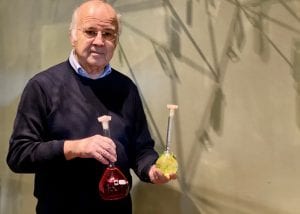 Eckhard Lenz's favourite pieces are two volumetric flasks made of laboratory glass from the Wertheim company Brand. "Wertheim laboratory glass - that is measuring technology of the highest precision," says the second chairman of the glass museum.
Eckhard Lenz's favourite pieces are two volumetric flasks made of laboratory glass from the Wertheim company Brand. "Wertheim laboratory glass - that is measuring technology of the highest precision," says the second chairman of the glass museum.
After Mainz, Wertheim is still the most important German production site for laboratory glassware for chemistry, pharmacy, medicine and research.
Jürgen Küchler
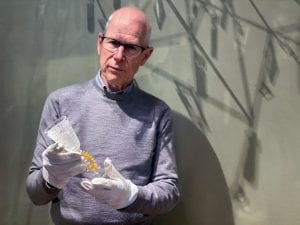 Jürgen Küchler's favourite piece: a filigree Venetian wing glass. "In the 12th century, Venetians succeeded for the first time in washing the glass clear like rock crystal," the museum's advisory board member reports. A special challenge, because glass naturally has a colour cast. Neutralising the green tint in the glass was only possible with the help of reddish manganese, the so-called glassmaker's soap.
Jürgen Küchler's favourite piece: a filigree Venetian wing glass. "In the 12th century, Venetians succeeded for the first time in washing the glass clear like rock crystal," the museum's advisory board member reports. A special challenge, because glass naturally has a colour cast. Neutralising the green tint in the glass was only possible with the help of reddish manganese, the so-called glassmaker's soap.
Glassblower
Frank Krause
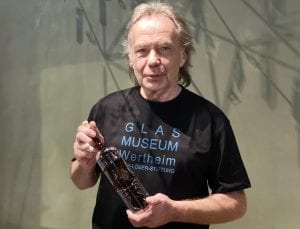 For Wertheim tourists and visitors to the museum, Frank Krause makes artistic bottles that can be filled with oil and vinegar at the same time. In addition to his work at the Wertheim Glass Museum, the glassblower runs his own glass workshop and was a specialist teacher at the Wertheim Glass College. He sells his glass objects through fellow glassblowers on the river cruise ships that moor on the Main near Wertheim: "The bottles sell particularly well there as souvenirs," the glass artist reports.
For Wertheim tourists and visitors to the museum, Frank Krause makes artistic bottles that can be filled with oil and vinegar at the same time. In addition to his work at the Wertheim Glass Museum, the glassblower runs his own glass workshop and was a specialist teacher at the Wertheim Glass College. He sells his glass objects through fellow glassblowers on the river cruise ships that moor on the Main near Wertheim: "The bottles sell particularly well there as souvenirs," the glass artist reports.
Ralf Marlok
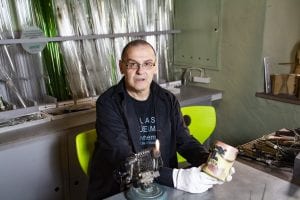 Glassblower Ralf Marlok's favourite piece is a thick-walled glass vase from 1976. The exhibit comes from the hand of Dale Chihuly, to this day the best-known living glass artist in the USA. The artist is best known for his oversized installations and floral glass sculptures in Venice, Israel, the Czech Republic and the USA, among other places. "You quickly get into conversation with American visitors to the museum," says Marlok, who works as a glassblower at the museum.
Glassblower Ralf Marlok's favourite piece is a thick-walled glass vase from 1976. The exhibit comes from the hand of Dale Chihuly, to this day the best-known living glass artist in the USA. The artist is best known for his oversized installations and floral glass sculptures in Venice, Israel, the Czech Republic and the USA, among other places. "You quickly get into conversation with American visitors to the museum," says Marlok, who works as a glassblower at the museum.
Museum shop
Tina Diehm
 "I love the art of glassblowing and its versatility," says Tina Diehm. "I'm particularly taken with filigree works," she continues. This explains her favourite piece: Till Eulenspiegel by Olaf Schönherr (Schweinfurt). "The graceful figure seems lively, colourful and delicate," says Tina Diehm. As an art glassblower, Olaf Schönherr is known above all for his skill in the overlay technique. These are works in which glassblowers fuse different coloured glass layers within an object and then blast the motifs out with sand.
"I love the art of glassblowing and its versatility," says Tina Diehm. "I'm particularly taken with filigree works," she continues. This explains her favourite piece: Till Eulenspiegel by Olaf Schönherr (Schweinfurt). "The graceful figure seems lively, colourful and delicate," says Tina Diehm. As an art glassblower, Olaf Schönherr is known above all for his skill in the overlay technique. These are works in which glassblowers fuse different coloured glass layers within an object and then blast the motifs out with sand.
Veronika Habel
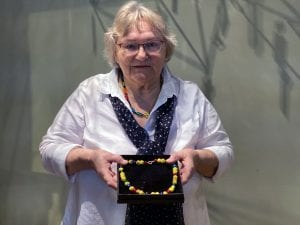 Veronika Habel works in the museum shop and is thrilled by the painstaking handiwork behind all the glasswork.
Veronika Habel works in the museum shop and is thrilled by the painstaking handiwork behind all the glasswork.
Her favourite piece is a necklace: "Every single glass bead is hand-wound on the flame," she reports, visibly fascinated. The necklace of summer-yellow glass beads was made, like other glass works in the shop, by Ute Schreml from Dinkelsbühl.
Elvira Kirchner
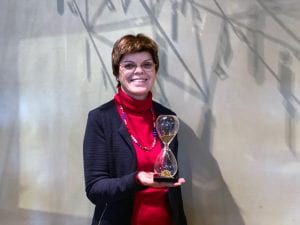 Elvira Kirchner is thrilled with the magnetic hourglass. Instead of sand, this specimen is filled with fine metal shavings. "When these touch the floor, the shavings pile up into wondrous formations," Kirchner describes. The forces of a magnet embedded in the wooden floor are responsible for this.
Elvira Kirchner is thrilled with the magnetic hourglass. Instead of sand, this specimen is filled with fine metal shavings. "When these touch the floor, the shavings pile up into wondrous formations," Kirchner describes. The forces of a magnet embedded in the wooden floor are responsible for this.
Museum service and guided tours
Martina König
 A crown is Martina König's favourite piece - not a princely one, but one worn by revue dancers. "On my tours with children, the crown of the revue dancers is the highlight," says Martina König. Because the opulent piece of jewellery not only glitters in all the colours of the rainbow, but is also perfect for explaining the physical properties of light: Why does light refract in cut glass? "Everyone is allowed to try on the crown - by the way, it is equally popular with boys and girls," reports the glass expert.
A crown is Martina König's favourite piece - not a princely one, but one worn by revue dancers. "On my tours with children, the crown of the revue dancers is the highlight," says Martina König. Because the opulent piece of jewellery not only glitters in all the colours of the rainbow, but is also perfect for explaining the physical properties of light: Why does light refract in cut glass? "Everyone is allowed to try on the crown - by the way, it is equally popular with boys and girls," reports the glass expert.
Brigitte Dosch
 "In England, New Zealand and Ireland, everyone knows this glass - that's why it's a highlight of my English-language tours of the glass museum," says Brigitte Dosch about her favourite piece - the so-called "Yard of Ale": a tall beer glass that, at around 91 cm long, holds around 1.14 litres. The glass was first mentioned in 1617 and later, in 1685, the high gentlemen are said to have drunk from a flint glass (glass with 24% lead content) like this one at the proclamation of King James II.
"In England, New Zealand and Ireland, everyone knows this glass - that's why it's a highlight of my English-language tours of the glass museum," says Brigitte Dosch about her favourite piece - the so-called "Yard of Ale": a tall beer glass that, at around 91 cm long, holds around 1.14 litres. The glass was first mentioned in 1617 and later, in 1685, the high gentlemen are said to have drunk from a flint glass (glass with 24% lead content) like this one at the proclamation of King James II.
Karin Haack
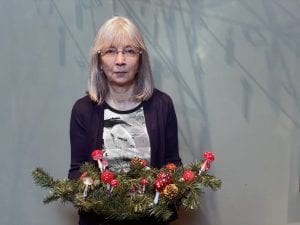 Karin Haack is fond of Christmas tree decorations from the 1920s and 30s: Toadstools made of frosted glass. "The simple elegance of the exhibits fits perfectly into the "Art Déco" period," enthuses the accountant. Lauscha in the Thuringian Forest was known for the production of Christmas tree decorations. For blowing thin-walled glass balls and ornamental pendants, a particularly hot flame is needed, which has to be produced with gas. So the glassblowers benefited from the gasworks that was built in Lauscha in 1867. The fine, precise work of these Thuringian Christmas tree ornament glassblowers is the cradle of the later laboratory glass industry.Every year at Christmas time, the GLASMUSEUM WERTHEIM reminds us of this with its large "Christmas tree ornaments made of glass" exhibition, which is now known beyond the region, with a bazaar and the popular ball-blowing event.The largest exhibit is the "Thuringian tree" in the entrance hall: a 4m high real fir tree, equipped with over 500 glass figurine elements made of glass.
Karin Haack is fond of Christmas tree decorations from the 1920s and 30s: Toadstools made of frosted glass. "The simple elegance of the exhibits fits perfectly into the "Art Déco" period," enthuses the accountant. Lauscha in the Thuringian Forest was known for the production of Christmas tree decorations. For blowing thin-walled glass balls and ornamental pendants, a particularly hot flame is needed, which has to be produced with gas. So the glassblowers benefited from the gasworks that was built in Lauscha in 1867. The fine, precise work of these Thuringian Christmas tree ornament glassblowers is the cradle of the later laboratory glass industry.Every year at Christmas time, the GLASMUSEUM WERTHEIM reminds us of this with its large "Christmas tree ornaments made of glass" exhibition, which is now known beyond the region, with a bazaar and the popular ball-blowing event.The largest exhibit is the "Thuringian tree" in the entrance hall: a 4m high real fir tree, equipped with over 500 glass figurine elements made of glass.
Sigrid Keller
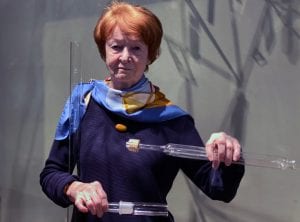 As with all the exhibits in the museum, Sigrid Keller also knows the history of her favourite pieces, glass tubes joined by cone cuts: "Until the 19th century, chemists used cork to connect glass tubes. The problem: cork is unstable and crumbles easily. At a Christmas market in Berlin, the famous chemist Justus von Liebig observed a glassblower from Thuringia and had an idea: why not make connectors out of glass? He spoke to the artist, who then invented the cone cut. The modern laboratory glass industry was born."
As with all the exhibits in the museum, Sigrid Keller also knows the history of her favourite pieces, glass tubes joined by cone cuts: "Until the 19th century, chemists used cork to connect glass tubes. The problem: cork is unstable and crumbles easily. At a Christmas market in Berlin, the famous chemist Justus von Liebig observed a glassblower from Thuringia and had an idea: why not make connectors out of glass? He spoke to the artist, who then invented the cone cut. The modern laboratory glass industry was born."
Hans Müller-Rodenbach
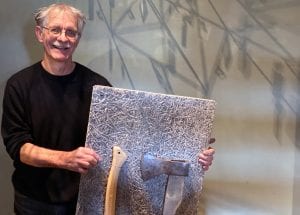 For Hans Müller-Rodenbach, the glass axes have above all a symbolic value: "For me, they are an expression of how sensitively the staff have to handle things here and how fragile the efforts sometimes are, but also that there is always a certain shine to them," explains the caretaker as he looks at the exhibits. In the case of the glass axes, the wooden handle and the axe blade were each made alternately of glass. The artist Sebastian Richter from Halle plays with the alienation of everyday things and forces the viewer to deal with new perspectives.
For Hans Müller-Rodenbach, the glass axes have above all a symbolic value: "For me, they are an expression of how sensitively the staff have to handle things here and how fragile the efforts sometimes are, but also that there is always a certain shine to them," explains the caretaker as he looks at the exhibits. In the case of the glass axes, the wooden handle and the axe blade were each made alternately of glass. The artist Sebastian Richter from Halle plays with the alienation of everyday things and forces the viewer to deal with new perspectives.
Evi Petzold
 "Drink well, live forever" is written on Evi Petzold's favourite piece. A fragile net of cut, three-coloured flashed glass encircles the bell-shaped body. As diatret glass ("pierced", Latin), Roman glassmakers produced magnificent drinking cups from the first century onwards. Josef Welzel cut a specimen according to the Roman Cologne model. Evi Petzold has been fascinated by this art since 1988. At that time, she visited the exhibition "Glass of the Caesars" in Cologne. One of the exhibits was a diatret glass from the 4th century. "I was just as enthusiastic about the original as I was about Josef Welzel's work," says the glass connoisseur.
"Drink well, live forever" is written on Evi Petzold's favourite piece. A fragile net of cut, three-coloured flashed glass encircles the bell-shaped body. As diatret glass ("pierced", Latin), Roman glassmakers produced magnificent drinking cups from the first century onwards. Josef Welzel cut a specimen according to the Roman Cologne model. Evi Petzold has been fascinated by this art since 1988. At that time, she visited the exhibition "Glass of the Caesars" in Cologne. One of the exhibits was a diatret glass from the 4th century. "I was just as enthusiastic about the original as I was about Josef Welzel's work," says the glass connoisseur.
Whether it is cut out of a flashed glass or out of two glasses that have been made into each other and then reground has been the subject of controversial discussions between our member Rosemarie Lierke (mathematician) and above all the Corning Museum (USA) since the 1990s.
Lothar Voss
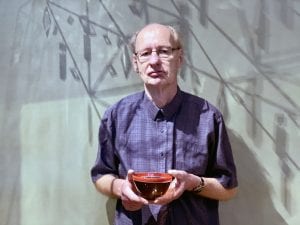 Glass art with clear forms and colours inspires Lothar Voss. His highlight in the Wertheim Glass Museum, for example, is the bowl made of lamp glass by Jürgen Schwarz (Lauscha/Thuringia). The exhibit from 1988 impresses not only because of its form, but also because of the fascinating colour combination of fiery orange and dark brown.
Glass art with clear forms and colours inspires Lothar Voss. His highlight in the Wertheim Glass Museum, for example, is the bowl made of lamp glass by Jürgen Schwarz (Lauscha/Thuringia). The exhibit from 1988 impresses not only because of its form, but also because of the fascinating colour combination of fiery orange and dark brown.